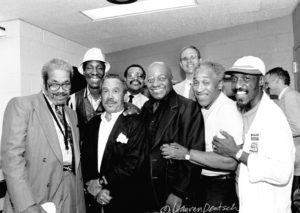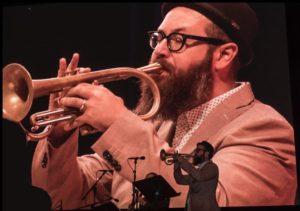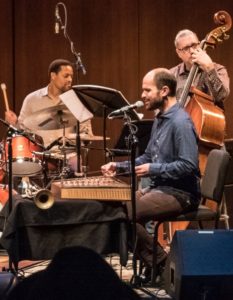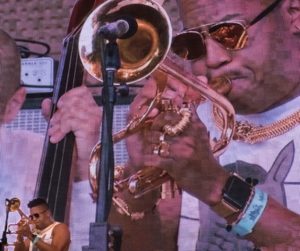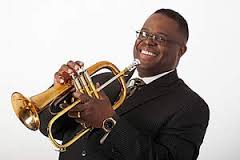I love the sound of a saxophone, or rather the broad range of sounds available from this family of reeds instruments. Breathy, vocal-like, smooth, light, penetrating, gritty or greasy, able to cry and/or croon (sometimes both at once), it strikes me as capable of the most personal of musical statements, although that’s probably a projection […]
City of Chicago, music promoter
Lollapalooza 2021 had some 385,000 attendees (without significant Covid-19 outbreak, fortunately) but featured little of host Chicago’s indigenous talent or styles. And that’s just wrong, declared Department of Cultural Affairs and Special Events commissioner Mark Kelly, launching the month-long Chicago in Tune “festival” at a reception August 19. Here’s the still-evolving event calendar of hundreds […]
Chicago Jazz fest images, echoes
The 41st annual Chicago Jazz Festival has come and gone, as I reported for DownBeat.com in quick turnaround. I stand by my lead that the music was epic — cf. Marc PoKempner‘s beautiful image of the Art Ensemble of Chicago at Pritzker Pavillion, facing east towards Mecca just before their African percussion-driven orchestral set. And […]
Labor Day jazz fests, starting with Chicago’s
The 40th annual Chicago Jazz Festival, four days free to all of unfettered, usually joyous music held in beautiful downtown Millennium Park, started last night with stars of of the local scene celebrating  “Legends and Lions”. Add “Ancient to the Future” to set the tone for a weekend of exciting, civically-supported music here — and similar outpourings of jazz […]
Jazz on Millennium Park’s big screen – PoKempner photos
A 40-by-22½-foot LED screen is a dominating feature of the stage in the Pritzker Pavilion of Chicago’s Millennium Park, difficult to ignore though many try. Photographer Marc PoKempner does the opposite in his shots from the 39th annual Chicago Jazz Festival: he uses what he (and everybody else) sees to create striking images, in the […]
Jazz/Improv Chicago: Wide-ranging talents, free fests, PoKempner pix
Chicago’s jazz/improvised music scene contains multitudes, last week ranging from the wild yet earnest Liberation Music Collective to veteran piano sophisticate Michael Weiss in trio, as two of Marc PoKempner‘s photos document (and more of his vision, focused on links between local music and politics — Obama included — is on exhibit titled “Harold’s Got […]
African roots, Middle Eastern extensions in Hyde Park Jazz Fest
Pianist Randy Weston, a magisterial musician at age 90 inspired by jazz traditions and its African basics, and trumpeter Amir ElSaffar, who has devoted himself to incorporating the Middle East’s modal, microtonal maqam legacy into compositions for jazz improvisation by members of his Two Rivers Ensemble, were highlights of last weekend’s 10th annual Hyde Park Jazz Festival. Both […]
Chi jazz fest 2016, details in photos and words
My DownBeat overview of the 38th annual Chicago Jazz Festival, comprehensive as I could make it, didn’t go into depth on any of the couple dozen performances I heard from Sept 1 through 4 in downtown Millennium Park and the Cultural Center. So here, with imagery by my photojournalist colleagues and friends Marc PoKempner and Michael Jackson (whose photo […]
A Great Migration suite from trumpeter Orbert Davis: Audio interview
Orbert Davis — trumpeter, composer and leader of the Chicago Jazz Philharmonic, has been commissioned by the Jazz Institute of Chicago to write and perform a suite about the Great Migration for the 38th annual free Chicago Jazz Festival. “Soul Migration,” for octet, will be heard Sept 1 at 8 pm in Millennium Park’s Pritzker Pavillion. […]
CareFusion drops jazz fest sponsorships
CareFusion, a global corp. specializing in hospital equipment, has ended its two-year sponsorship of George Wein’s New York Jazz Festival and Newport Jazz Festival, and the Chicago Jazz Festival, a day after reporting the retirement of its Chairman and CEO David L. Schlotterbeck, and the first quarter financials of its 2010 fiscal year. The company announced […]
Mayor Daley’s music and arts
Shocking news from Chicago: Richard Daley won’t be mayor for life. Yet he’s the Windy City’s most significant patron of culture, leaving a legacy that ought to — that is, should, and might — survive him. Which was unexpected when he succeeded Mayor Harold Washington in 1989, but clear from my visit to Labor Day […]
Little known great jazz in Chicago’s neighborhoods
The Jazz Institute of Chicago‘s annual club tour is an urban presentation innovation and a treat, revealing an unheralded depth of local audiences, entrepreneurs and artists. On Wednesday night, Dudley Owens blew tenor sax with the largest sound I’ve heard maybe ever, in combo with an older pianist (sorry I didn’t get his name) who […]
Best American city for jazz? Chicago
I’m a Chicago homie — long removed but never really gone — so don’t expect objectivity, but a recent visit proved my native metropolis is #1 in America and maybe everywhere for its active, creative, meaningful, almost-economically-viable, neighborhood-rooted, exploratory and world class jazz. I say this even as my dearly adopted New York City kickstarts as […]

